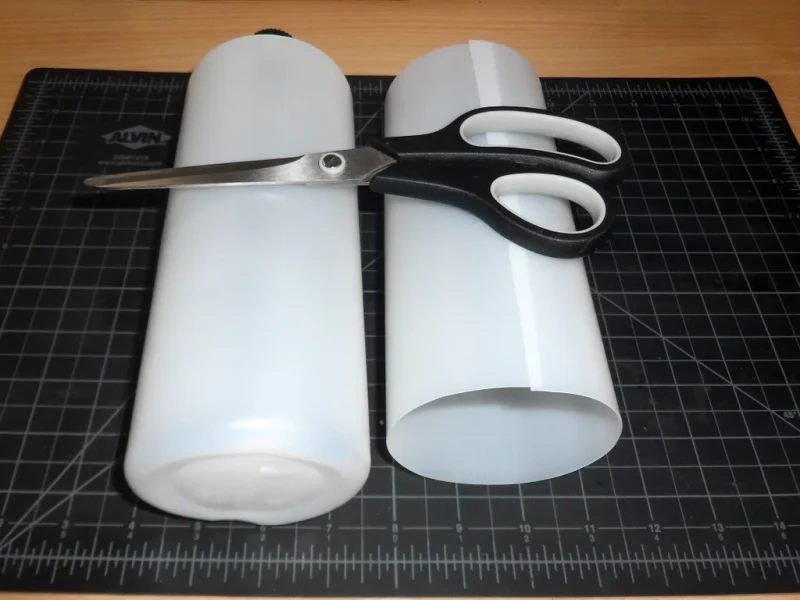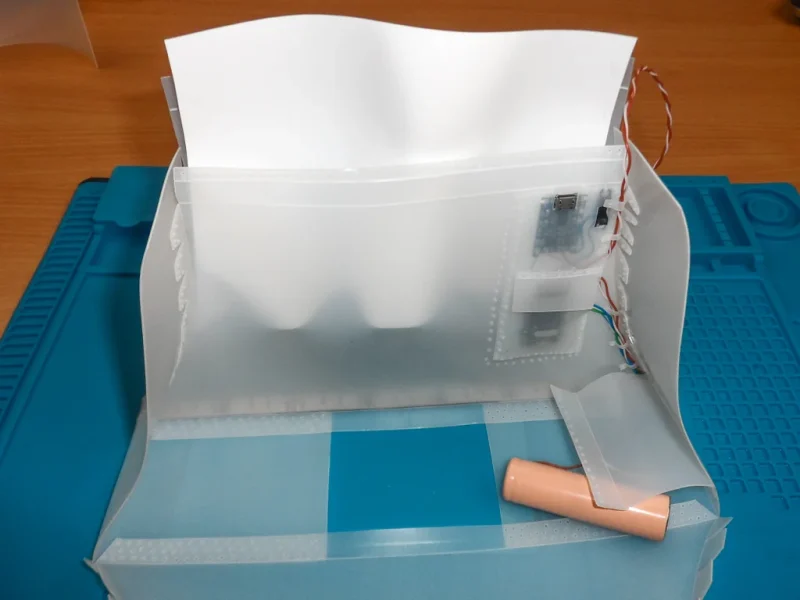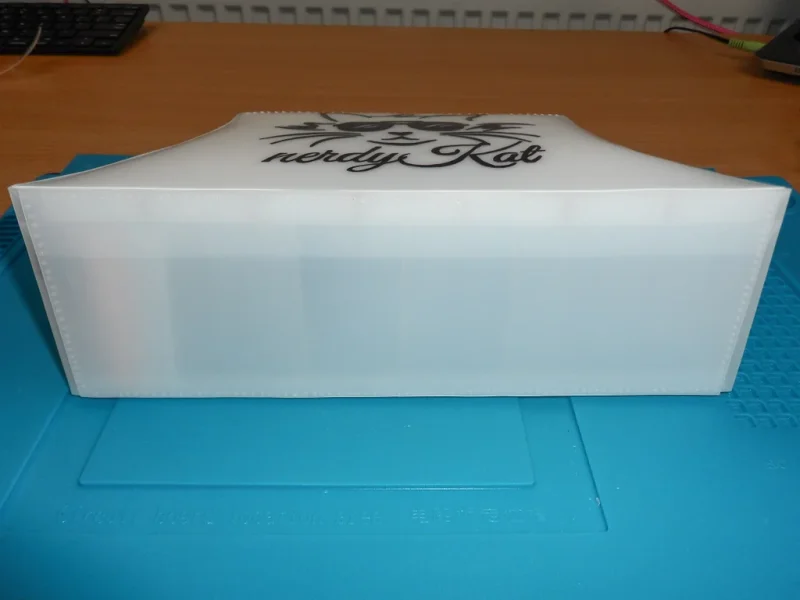LED HDPE Plastic Handbag
I’ve been saving the 1L HDPE bottles for a while now, mainly because once you cut off the top and the bottom, you will end up with a nice, straight piece of relatively thick plastic that can be easily shaped and welded into all sorts different things. And so I decided to make another handbag for those who liked my first one, but don’t have a sewing machine. Here goes 😉
Materials And Tools
- 5 x 1L HDPE bottles
- Design marker
- Polyurethane craft varnish
- Slide switch
- Arduino Pro mini
- TP4056 18650 battery charger
- 18650 battery – salvaged from an old laptop battery
- Addressable LED strip
- double sided tape
- Wires – damaged Ethernet cable
- 2 x Snap fasteners
- small push switch
Tools:
- scissors
- craft knife
- soldering iron (I tend to use a separate one for welding plastics)
- needle & thread
Step 2: Logo & Cutting
To make the handbag look more interesting I decided to draw my logo onto it with a design marker. If you would like to replicate this project I’ve left a space in the template for you to draw your own design.
For tracing I used a craft knife. I began by placing the plastic sheet onto the template, secured it in place with clear tape and gently traced the lines with a craft knife.
For the next step I contemplated on using the scissors, but the scored plastic is really easy to bend and cut through with a knife, thus leaving a nicer, sharper result.
To protect the design drawn with the marker I applied a coat of Polyurethane craft varnish, otherwise it would easily scratch off overtime.
Step 3: Bending
Before welding the handbag together, I proceeded to bend the pieces along the scored lines. Most of these were inward bends apart from the very top of the front and back pieces where the handles would later be attached to and the top of the inner wall. For these I bent them inwards first and then outwards.
Step 4: Circuit
For this step I started by uploading the code to the Arduino and attached the header pins, so that the code could be easily re-uploaded later.
I wanted all of the electronics in the bag to have a fixed position, but with the switch, charger and Arduino still easily accessible. So I decided to position the switch in the upper right corner of the inner wall with the charger right next to it and Arduino just under the charger.
To do this I cut a hole big enough for the switch to slide through the inner wall and stitched the switch onto the inner wall with a needle and thread to secure it in place. Next I soldered two wires onto the switch and pushed them through the gap in between the switch and the inner wall. These wires were than attached to the positive output on the charger and the VCC pin of the Arduino. Another wire was connecting the negative output of the charger and the ground pin of the Arduino, followed by two more wires for the battery.
Next I soldered the two wires for the push button onto the pin 2 and ground pin and three wires for the LEDs onto the pin 6, VCC and GRD pin.
To make sure everything works as intended, I attached the wires onto the LEDs and the battery and shorted the push button wires. To make the soldering onto the battery easier and avoid applying too much heat I gently filed both ends of the battery with a nail file.
Since everything worked as desired, I removed the wires from the LEDs and the battery and stitched the charger and Arduino to the inner wall.
Step 5: Welding
The melting point of HDPE (High Density Polyethylene) is 130°C so I set my soldering iron to about 280°C. I found this to be the sweet spot in between having to wait to long and burning the plastic. Also I don’t really know the exact temperature since the soldering iron I’m using is one of those cheap ones and they are not very reliable in the precise temperature department. I own a few soldering irons and this one is no longer being used for it’s original purpose. So if you decide to make your own bag I would suggest to have a little test run with scrap pieces and adjust the temperature accordingly.
I wanted to make sure that all of the electronics in the bag would be protected from any accidental shorting, so I took a larger scrap piece and cut out holes for the USB, switch and the Arduino header.
To begin the welding process, I slid the cover over the header and aligned it with the inner wall, then I poked a lot of holes through the two plastic layers with the tip of the soldering iron to create a strong joint. Then I attached the hood for the Arduino headers.
Next I aligned the bottom edges of the front and side piece and welded along the overlap from the inside. For the side I laid the piece horizontally with the front facing upwards, then I pinched the edge of the side piece and aligned it with the bottom edge of the front piece and welded from the outside. I carried on aligning and welding the two pieces together all the way up and repeated for the other side. Once the two sides were erected I spot welded each tab of the front piece from the inside.
When it comes to creating shapes from plastic sheets, you can pretty much treat it as a paper craft project except you would use heat to create a bond instead of glue.
Step 6: Inner Wall
To keep the wires organized and out of the way, I cut the inner wall tabs wherever necessary into smaller strips and used those as wire fasteners.
Before attaching the inner wall to the bag, I applied some double sided tape onto the LED strip, shortened and soldered the wires from the Arduino and attached it to bottom of the front piece. Then I welded the inner wall to the bottom of the bag and proceeded to align and weld each tab of the inner wall from the outside and then from the inside.
Next I shortened and soldered on the battery wires and made a small battery cover.
Step 7: Adjustments
Upon turning on the LEDs I found the electronics to be a little distracting and so I decided to cover the inner wall with a piece of white plastic sheet salvaged from an old monitor, stuck onto the inside of the inner wall with some double sided tape. This could be easily substituted with any white sheet. Once that’s done I secured the top of the inner wall onto the top of the front piece from the outside.
Next I attached the back to the bottom of the bag and welded from the inside and welded the sides from the outside. After that I cut off the protruding sides with scissors.
Step 8: Snap Fasteners
For the closing mechanism I decided to go with the sew on snap fasteners. I cut two small holes on the back side of the bag for the bulging parts of the fasteners to sit in and welded on the handles to the front and back of the bag. Next I sewed on the fasteners and welded on the bottom piece of the bag.
Step 9: Finishing Off
To finish off I cut a small rectangle into the top layer, just next to one of the back fasteners for the push button. I cut a few smaller strips from the leftover plastic sheet and used them to secure the push button wires in place. Next I shortened the wires and soldered them onto the push button. At the end I cut another small piece of plastic with a rectangular opening and welded that over the push button to keep it in place.
Final Thoughts
I love how the handbag turned out. I manged to get 22 hours of continues illumination on a 5 hour charge, but this will hugely depend on the battery itself. This bag could be used especially if you like to stand out in a crowd or as a safety measure on those walks home at night. It could also be used as a night light since it gives enough light to let you see where you’re walking but it’s not blinding. Also the cost of making the bag is very low since most of the items necessary could be salvaged from the recycle bin and broken electronics.

Runner Up in the
Make it Glow Contest

















































